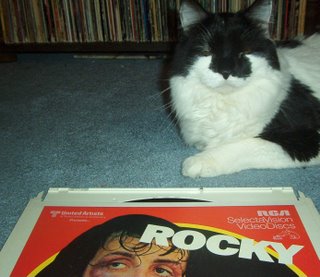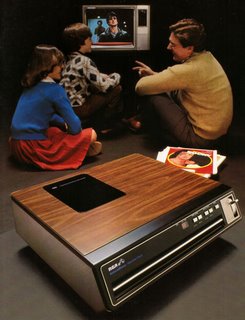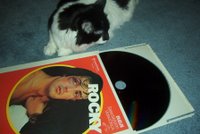Tuffy the Cat's Museum of Obsolete Entertainment Formats, Vol. I -- the CED VideoDisc
 Hi, I'm Tuffy. I'm a cat. More specifically, I'm one of DJMurphy's three cats. And let me tell you; he's a knucklehead. I mean, sure, he feeds me regularly, and when I beg like a mad cat, he'll pet my hindquarters. And yeah, he's got a good lap to curl up in. But he's still a knucklehead. He saves the weirdest things. Stuff NO ONE (including himself) will ever be able to use. Which is why I've hacked into his blog to post just what kind of nut he is, for saving the objet d'desuet I'm going to tell you about today: the RCA SelectaVision VideoDisc.
Hi, I'm Tuffy. I'm a cat. More specifically, I'm one of DJMurphy's three cats. And let me tell you; he's a knucklehead. I mean, sure, he feeds me regularly, and when I beg like a mad cat, he'll pet my hindquarters. And yeah, he's got a good lap to curl up in. But he's still a knucklehead. He saves the weirdest things. Stuff NO ONE (including himself) will ever be able to use. Which is why I've hacked into his blog to post just what kind of nut he is, for saving the objet d'desuet I'm going to tell you about today: the RCA SelectaVision VideoDisc.Put simply, imagine a great black, 12" vinyl record... that holds 60 minutes of video per side.
 Add a cool hard-plastic caddy, a unique way to insert the disc, and you've got a great new video format!! It'll be a great success!! ...Or at least, that's what the fine folks at RCA Corporation were hoping when they introduced what has been termed "Needle Vision" by silly humans trying to be cute. The format was made in America by an American company, one of the last few entertainment technologies to sport that claim. I'm made in America; I wonder if that's one of the charming reasons that Murph loves me. (Maybe it's the hairballs; I could always yak up a couple of more of those onto his clean carpet, just to let him know how much I care about him. Even if he is a knucklehead, he's my knucklehead.) The video discs are referred to as CED discs, which stands for Capacitance Electronic Disc. Each disc came in a hard-shelled plastic caddy, about as thick as a triple record set in a four-panel sleeve (think the Woodstock soundtrack, or Yessongs). The entire caddy with the disc inside was inserted into the video disc player, the power to the player was turned on, and the caddy was removed, keeping the disc in the player. The disc would then spin at 450 RPM, and would have to be flipped at typically the halfway point of the movie. Screen resolution was equivalent to VHS video tapes, about 250 lines of resolution.
Add a cool hard-plastic caddy, a unique way to insert the disc, and you've got a great new video format!! It'll be a great success!! ...Or at least, that's what the fine folks at RCA Corporation were hoping when they introduced what has been termed "Needle Vision" by silly humans trying to be cute. The format was made in America by an American company, one of the last few entertainment technologies to sport that claim. I'm made in America; I wonder if that's one of the charming reasons that Murph loves me. (Maybe it's the hairballs; I could always yak up a couple of more of those onto his clean carpet, just to let him know how much I care about him. Even if he is a knucklehead, he's my knucklehead.) The video discs are referred to as CED discs, which stands for Capacitance Electronic Disc. Each disc came in a hard-shelled plastic caddy, about as thick as a triple record set in a four-panel sleeve (think the Woodstock soundtrack, or Yessongs). The entire caddy with the disc inside was inserted into the video disc player, the power to the player was turned on, and the caddy was removed, keeping the disc in the player. The disc would then spin at 450 RPM, and would have to be flipped at typically the halfway point of the movie. Screen resolution was equivalent to VHS video tapes, about 250 lines of resolution. Originally, the technology was supposed to hit the market in the late '70s. However, had it arrived then, the discs would have been a crazy metallized disc that wouldn't have been that durable. Plus, the players would have been top loaders, which could have meant shorter player life if humans could have a go at monkeying with the equipment inside. By my feline estimation, the finished disc product that ultimately came to market in 1981 could very easily have been created using modified LP production lines. By keeping the discs in the caddies, there was no chance of humans putting their oily fingerprints on the disc surface, which would have seriously degraded the playability of the CED video discs. (Isn't it wild that a cat knows all this crap? You've only scratched the surface...). The 1981 product launch was a splashy affair, with really strong support from most of the major movie studios. In 1982, RCA even came out with a stereo version of the C
Originally, the technology was supposed to hit the market in the late '70s. However, had it arrived then, the discs would have been a crazy metallized disc that wouldn't have been that durable. Plus, the players would have been top loaders, which could have meant shorter player life if humans could have a go at monkeying with the equipment inside. By my feline estimation, the finished disc product that ultimately came to market in 1981 could very easily have been created using modified LP production lines. By keeping the discs in the caddies, there was no chance of humans putting their oily fingerprints on the disc surface, which would have seriously degraded the playability of the CED video discs. (Isn't it wild that a cat knows all this crap? You've only scratched the surface...). The 1981 product launch was a splashy affair, with really strong support from most of the major movie studios. In 1982, RCA even came out with a stereo version of the C ED player, which coincided with the release of the stereo CED video disc of Star Wars. Ultimately, some 1700 CED video disc titles were released. Sounds like a recipe for success, right?
ED player, which coincided with the release of the stereo CED video disc of Star Wars. Ultimately, some 1700 CED video disc titles were released. Sounds like a recipe for success, right?The format ended up being a failure, ultimately, due to really bad timing. The VHS videotape emerged at almost the same time, and when new adopters were faced with a format which allowed you to play AND record, as opposed to the CED's play-only discs, the decision was pretty clear for the consumers. RCA stopped active development of the players in 1983, but since the actual video discs themselves were still selling, RCA continued production on them until 1986. It is curious to see that the more commonly known, optical technology LaserDisc continued on as a niche product up until it was ultimately replaced by the DVD. It ultimately must have had better corporate backing and marketing, along with the support of the cineastes. But these last few points are mere speculation, and I am merely a cat.
All was not a waste with CED, though. For the longest time, this was t
 he only format you could get the preferred version of The Kids Are Alright, with the entire Rolling Stones' Rock 'n Roll Circus performance of "A Quick One (While He's Away)", arguably the finest performance of the Who ever captured on film. But now that you can get that footage on the current DVD of the movie, why invest in early '80s technology? Save your sheckels, and treat your cats to another baggie of catnip; trust me, they'll thank you.
he only format you could get the preferred version of The Kids Are Alright, with the entire Rolling Stones' Rock 'n Roll Circus performance of "A Quick One (While He's Away)", arguably the finest performance of the Who ever captured on film. But now that you can get that footage on the current DVD of the movie, why invest in early '80s technology? Save your sheckels, and treat your cats to another baggie of catnip; trust me, they'll thank you.Extra special thanks to the website CED magic, from which the archival image and 98% of this information is presented more reverently than it is presented here.
Here's a wicked cool commercial of the player from YouTube. Worth the 30 seconds it takes to watch, especially if you want to see one of these babies in action.
2 Comments:
Jesus, I remember these. And, in a show of geeky solidarity, I too have visited the website that you've linked.
I can't believe you have one of these things
Yeah, actually two of them (the other is Chinatown). But ironically, no player to play them.
That website is amazing, in that it shows genuine love and affection for the format. And the factory employees in Indianapolis who made the discs... truly its own wonder. Are there websites out there like this for those boxy mobile phones that were the size of videotapes? And do I really want to know the answer to that question...
Post a Comment
<< Home